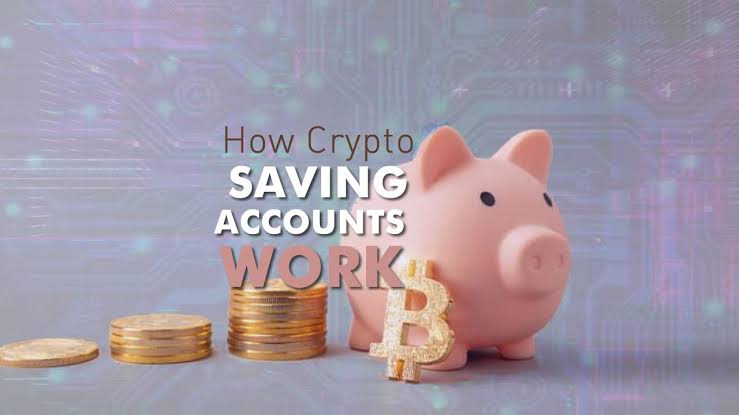A growingly significant portion of the cryptocurrency market is lending and borrowing coins, which could ultimately influence market pricing and valuation of the underlying assets. The concept of allowing assets to generate a return independent of the underlying asset’s price appreciation is appealing to many, as many cryptocurrency enthusiasts invest in the market with a long-term perspective anyway.
The popularity of cryptocurrency savings accounts, which offer high annual percentage yields (APYs), has given investors the opportunity to increase the returns on their cryptocurrency deposits.
What is a Crypto Savings Account
Crypto savings accounts work on a similar principle to conventional savings accounts. As a cryptocurrency owner, you have the option to place your assets in a crypto savings account. A third-party provider will then lend the money out on your behalf, paying you interest on your deposits.
With crypto savings accounts, the main distinction is that your money is kept in the cryptocurrency of your choice rather than being deposited in fiat money. Additionally, the volatility and price swings of the cryptocurrency market may affect your funds.
The primary distinction between a crypto wallet and a crypto savings account is that the former pays interest while the latter does not.
If you just keep your coins in a wallet where you own the private keys or in an exchange wallet, your investment will not earn any interest. To earn money for your crypto, you will need to open an account with a provider and deposit funds into your crypto savings account.
How It Operates
It is probably a good idea to become completely informed about cryptocurrency savings accounts and how they differ from traditional savings accounts before opening one. When you deposit money into a traditional savings account, you are authorising the bank to lend that money to other people. And the bank gives you interest in exchange.
Likewise, if you invest in cryptocurrencies such as Bitcoin or Ethereum, the provider of your cryptocurrency savings account will lend out the cryptocurrency to borrowers while charging you a predetermined interest rate. The current market rate is one of many variables that affects interest rates.
Cryptocurrency Savings Account Benefits
The cryptocurrency economy as a whole as well as individual investors can benefit from crypto savings accounts in a number of ways.
1.Passive Income: Crypto savings accounts offer an automated way to gradually increase a portfolio of cryptocurrencies. If someone is already fully invested in bitcoin, all they have to do is put that money into a crypto savings account to start receiving interest payments in bitcoin.
2.Increased Liquidity: The conversion of fiat money into cryptocurrency is encouraged by cryptocurrency savings accounts. Increased participation in the crypto economy can result in increased liquidity and ultimately stable asset prices.
3.Increased Adoption: Prominent cryptocurrency owners are encouraged to transfer their holdings from storage to the marketplace, which promotes adoption and encourages the development of new applications for cryptocurrency.
4.Increased Demand: Interest rates play a crucial role in the financial markets by mediating the gap between those who have an excess of assets and those who require them for specific purposes. The high demand for the underlying crypto assets can be attributed to the high interest rates being offered.
Risks associated with Crypto Savings Accounts
Investors should be aware that there are risks associated with savings accounts, even though the possibility of earning 8% or more seems alluring. In general, cryptocurrency carries risk, so one should only make an investment after thoroughly understanding the risks involved.
1.Price Volatility: The worth of cryptocurrencies is erratic and subject to sudden drops. Since cryptocurrency is not backed by the government, investors would lose their initial investment if something were to happen to cause it to lose its underlying value.
2.Lock Up Risk: Because certain cryptocurrency savings accounts are so flexible, investors can take money out at any time. Others might have lock-up times or extra costs if they make too many withdrawals. In general, accounts with greater restrictions will typically have higher interest rates, while accounts with less restrictions typically have lower interest rates. Prior to choosing a provider, be sure to conduct some research.
3.Pledge Risk: Your assets become collateral when you deposit them into a crypto savings account; you are no longer in control of the cryptocurrency. For instance, you are staking a claim to the bank’s liability when you make a deposit. With regard to the cryptocurrency savings account, things are similar. It is not possible for you to reclaim your assets in the event that the cryptocurrency provider fails because of poor business management or a negative market event.
4.Risk associated with Smart Contracts: Decentralised finance (Defi) lenders lend money and distribute capital through automated programming known as smart contracts. This coding is very transparent because it is visible to all. Everyone has an incentive to ensure that the coding is accurate.
In conclusion,While a crypto savings account can produce exceptionally lucrative returns for long-term investors, it is important to remember that the cryptocurrency market is known for its volatility. Crypto savings accounts might accrue interest like a traditional savings account, but they do not have the same financial protections that are awarded to traditional banking institutions.
If you do decide to open a crypto savings account, treat it as an investment account instead of a separate checking account. Keep your emergency funds somewhere safe, and never invest more money than you can afford to lose in cryptocurrency


